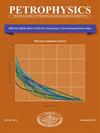Flow-Dependent Relative Permeability Scaling for Steady-State Two-Phase Flow in Porous Media: Laboratory Validation on a Microfluidic Network
IF 0.7
4区 工程技术
Q3 ENGINEERING, PETROLEUM
引用次数: 1
Abstract
Conventionally, the relative permeabilities of two immiscible fluid phases flowing in porous media are considered and expressed as functions of saturation. Yet, this has been put into challenge by theoretical, numerical, and laboratory studies of flow in artificial pore network models and real porous media. These works have revealed a significant dependency of the relative permeabilities on the flow rates, especially when the flow regime is capillary to capillary-viscous dominated, and part of the disconnected nonwetting phase remains mobile. These studies suggest that relative permeability models should include the functional dependence on flow intensities. However, revealing the explicit form of such dependence remains a persistent problem. Just recently, a general form of dependence was inferred based on extensive simulations with the DeProF model for steady-state two-phase flows in pore networks. The simulations revealed a systematic dependence of the relative permeabilities on the local flow rate intensities. This dependence can be described analytically by a universal scaling functional form of the actual independent variables of the process, namely, the capillary number, Ca, and the flow rate ratio, r. The proposed scaling incorporated a kernel function, the intrinsic dynamic capillary pressure (IDCP) function, describing the transition between capillarity- and viscosity-dominated flow phenomena. In a parallel laboratory study, SCAL measurements provided a preliminary proof-of-concept on the applicability of the model. In the laboratory study presented here, we examine the applicability of the scaling model by taking extensive, ex-core measurements of relative permeabilities for steady-state co-injections of two immiscible fluids within an artificial microfluidic pore network, across different flow regimes in Ca and r. From these measurements, we calculate the values of the mobility ratio, and we compare these to the corresponding values of the flow rate ratio. We also extract the IDCP curve, the locus of critical flow conditions, whereby the process is more efficient in terms of energy utilization – accounted by the nonwetting phase flow rate per unit of total power provided to the process, as well as the locus of flow conditions of equal relative permeabilities. We show that the degree of consistency between flow rate ratio and mobility ratio values, the IDCP curve, the locus of critical flow conditions, and the locus of equal relative permeabilities, as well as some associated invariant characteristic values, can be used for assessing the extent of end effects and for characterizing the flow as capillary- or viscous-dominated. The proposed scaling introduces new opportunities for enhancing SCAL protocols and their associated applications. These include the characterization of systems and flow conditions, dynamic rock typing, evaluation of capillary end effects, as well as the advancement of more efficient field-scale simulators. Additionally, it paves the way in designing more energy-efficient EOR interventions.多孔介质中稳态两相流的相对渗透率缩放:微流体网络的实验室验证
传统上,在多孔介质中流动的两种非混相流体的相对渗透率被考虑并表示为饱和度的函数。然而,人工孔隙网络模型和真实多孔介质中流动的理论、数值和实验室研究对这一观点提出了挑战。这些工作揭示了相对渗透率对流速的显著依赖,特别是当流动状态为毛细管-毛细管粘性主导时,部分断开的非润湿相保持流动。这些研究表明,相对渗透率模型应该包括对流动强度的功能依赖。然而,揭示这种依赖的明确形式仍然是一个长期存在的问题。就在最近,基于对孔隙网络中稳态两相流的DeProF模型的大量模拟,推断出了一种一般形式的依赖关系。模拟结果揭示了相对渗透率与局部流速强度之间的系统依赖关系。这种依赖关系可以用过程中实际自变量的通用标度函数形式来解析描述,即毛细管数Ca和流速比r。所提出的标度包含了一个核函数,即内在动态毛细管压力(IDCP)函数,描述了毛细管主导和粘度主导的流动现象之间的转变。在一个平行的实验室研究中,SCAL测量提供了模型适用性的初步概念证明。在这里提出的实验室研究中,我们通过对人工微流体孔网络中两种不混相流体在Ca和r中不同流动状态下的稳态共注入的相对渗透率进行广泛的岩心外测量,来检验标度模型的适用性。从这些测量中,我们计算了迁移率比的值,并将这些值与相应的流量比值进行了比较。我们还提取了IDCP曲线,即临界流动条件轨迹,即该过程在能量利用方面更有效-由提供给该过程的每单位总功率的非湿相流率以及相等相对渗透率的流动条件轨迹来计算。我们表明,流量比和流度比值、IDCP曲线、临界流动条件轨迹和等相对渗透率轨迹之间的一致性程度,以及一些相关的不变特征值,可用于评估末端效应的程度,并用于表征毛细管或粘滞主导的流动。提出的扩展为增强SCAL协议及其相关应用引入了新的机会。这些包括系统和流动条件的表征,动态岩石类型,毛细末端效应的评估,以及更有效的现场规模模拟器的进步。此外,它还为设计更节能的EOR干预措施铺平了道路。
本文章由计算机程序翻译,如有差异,请以英文原文为准。
求助全文
约1分钟内获得全文
求助全文
来源期刊

Petrophysics
地学-地球化学与地球物理
CiteScore
1.80
自引率
11.10%
发文量
40
审稿时长
>12 weeks
期刊介绍:
Petrophysics contains original contributions on theoretical and applied aspects of formation evaluation, including both open hole and cased hole well logging, core analysis and formation testing.
 求助内容:
求助内容: 应助结果提醒方式:
应助结果提醒方式:


